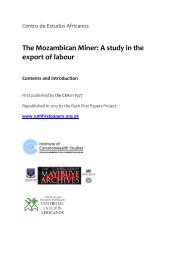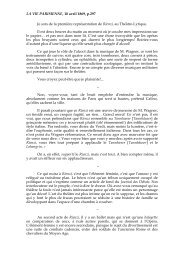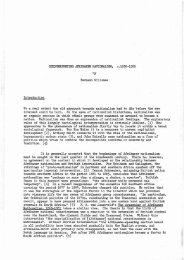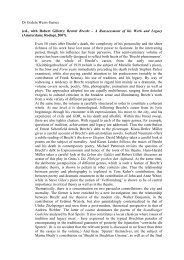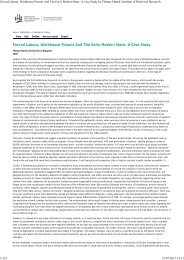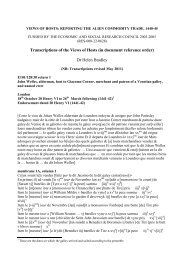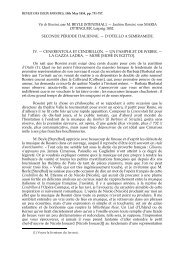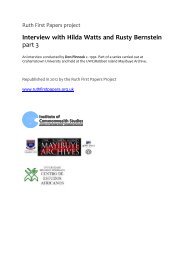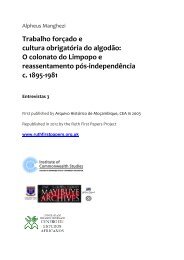Roraima: Brazil's northernmost frontier by John Hemming - SAS-Space
Roraima: Brazil's northernmost frontier by John Hemming - SAS-Space
Roraima: Brazil's northernmost frontier by John Hemming - SAS-Space
Create successful ePaper yourself
Turn your PDF publications into a flip-book with our unique Google optimized e-Paper software.
lived mission on the upper Surumu, but it failed when disease forced his<br />
Indians to flee to the forests. 'Father Thomas, deserted, sick and famished,<br />
finally made his way with one companion to the station and the effort to<br />
Christianize the Indians was abandoned.' 55 The missionary transferred his<br />
effort to the lower Uraricoera, where the American William Curtis Farabee<br />
met him in 1914.<br />
Thirteen years later, General Candido Rondon was appalled to find a<br />
British Jesuit, presumably Father Cary-Elwes, spending months in Brazil<br />
among the Wapixana, building chapels and persuading them to migrate<br />
across the border to his Saint Ignatius mission. Rondon also heard that a protestant<br />
pastor was doing likewise on the slopes of Mount <strong>Roraima</strong>. These<br />
were the Seventh-Day Adventists Alfred and Betty Cott who arrived there<br />
in 1927 and for a few years occupied former Benedictine chapels inside Venezuela<br />
near the <strong>frontier</strong>.<br />
In 1910 the Brazilian government created the Indian Protection Service<br />
(SPI) to protect its native tribal peoples. The last surviving national fazenda,<br />
Sao Marcos, was awarded to the SPI to administer. For a time, using Makuxi<br />
cowhands and improved ranching techniques, Sao Marcos's administrators<br />
increased its herd. Joaquim Gondim in 1921 was impressed to find its cattle<br />
of good quality and numbering 8,000 - well up from the miserable 3,500 left<br />
<strong>by</strong> Sebastiao Diniz. The Makuxi were well housed and their children<br />
received primary schooling.<br />
The Indian Protection Service sought to do more than merely manage<br />
its ranch, at this time. It opened more schools for Indians, a sanatorium on<br />
the Cotingo two days' ride from Sao Marcos, and an outpost called Limao on<br />
the upper Surumu for some Makuxi and Taurepang. When General Rondon,<br />
the great head of the SPI, visited the area and climbed Mount <strong>Roraima</strong><br />
in 1927, he was able to visit these establishments. But, curiously, SPI<br />
activity declined after Rondon's visit. It neglected its brief to protect Indians;<br />
and <strong>by</strong> 1944 Dr. Araujo Lima wrote that even the national fazenda Sao<br />
Marcos was 'in utter decay which is accentuated daily <strong>by</strong> its abandonment,<br />
without the introduction of any advanced techniques of cattle or horse<br />
breeding'. 56<br />
When General Rondon was on the upper Tacutu in 1927, Chief Manuel<br />
Barreto of the Makuxi complained to him that persecution <strong>by</strong> the local<br />
sheriff was forcing his people to seek greater freedom in British Guiana.<br />
Rondon commented: 'What a difference between the English of Guiana and<br />
the Brazilians on the <strong>frontier</strong>. The former seek to attract all the Indians of the<br />
region to their territory, the latter persecute their compatriots, forcing them<br />
into exile...It is interesting to note that these Indians have a reputation of<br />
being thieves in Brazil and cross into Guiana where they are well received <strong>by</strong><br />
the English who consider them good men.' 57 Another Brazilian general,<br />
Lima Figueiredo, found the situation unchanged fifteen years later. He was<br />
impressed <strong>by</strong> the clever propaganda of British missionaries to attract



